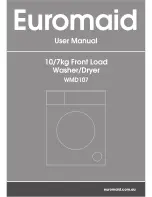
22
American Dryer Corporation
113549 - 8
a. Outside Ductwork Protection
1) To protect the outside end of the horizontal ductwork from the weather, a 90° elbow bent downward
should be installed where the exhaust exits the building. If the exhaust ductwork travels vertically up
through the roof, it should be protected from the weather by using a 180° turn to point the opening
downward. In either case, allow at least twice the diameter of the duct between the duct opening and
nearest obstruction.
IMPORTANT: DO NOT use screens, louvers, or caps on the outside opening of the exhaust ductwork.
IMPORTANT: Exhaust back pressure measured by a manometer/magnehelic in the exhaust duct must be
no less than 0 and must not exceed 0.3 in WC (0.74 mb).
NOTE: It is recommended that exhaust or booster fans not be used in the exhaust ductwork system except
where necessary to maintain exhaust back pressure (in the exhaust duct) between zero and 0.3 inch
water column. Where employed, booster fans must not activate the dryer airflow proving switch
(sail switch) when the dryer is not in operation.
NOTE: When the exhaust ductwork passes through a wall, ceiling, or roof made of combustible materials,
the opening must be 2-inches (5.08 cm) larger than the duct (all the way around). The duct must
be centered within this opening.
















































